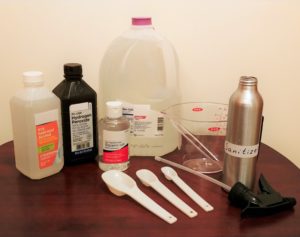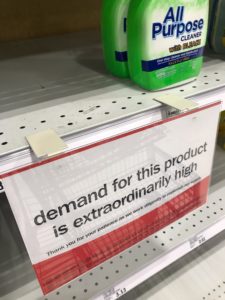and everyone needs to take care.
So many things you wouldn’t touch (even on a dare).
I thought I’d share
how to keep hands and kitchenware
clean and sanitized now that you are aware!
After the run on toilet paper, people started stocking up on cleaning wipes and hand sanitizer. Then it was bleach, dish soap and other household cleaners. As we move through this health crisis, the daily advice is to wash your hands often and to clean and disinfect frequently touched surfaces.
These steps slow the spread of the virus and reduce our risk of contracting illness even if we do come in contact with it at some point. What if you don’t have a disinfectant or sanitizer? Several weeks later, it is still next to impossible to find cleaning wipes or hand sanitizer in a store. Even though store bought cleaning wipes and hand sanitizer are convenient, it is not too hard to make your own effective substitutions at home with basic supplies and ingredients.
Start by cleaning your surfaces with soap or detergent and water and then rinsing well. Plain soap and water does a lot of good! Then, it is easy to make a simple disinfecting/sanitizing solution(PDF) for household surfaces made from liquid chlorine bleach and water. For best results, use a container of bleach that has not been open longer than 30 days, as it will begin to lose its effectiveness over time.
- If you are making a solution for disinfecting to destroy bacteria or viruses due to any illness (such as in the case of COVID-19), use a solution of
- 5 Tablespoons (1/3 cup) of bleach to 1 gallon of water OR
- 4 teaspoons of bleach to 1 quart of water
- *Use only UNSCENTED bleach on food contact surfaces, as fragrances may carry into foods.
- If you are making a solution to sanitize food contact surfaces and dishes for everyday use, when not dealing with illness, then two things may change:
- Use only UNSCENTED liquid chlorine bleach (if you weren’t already)
- Proportion of ingredients
- 1 Tablespoon of bleach to 1 gallon of water OR
- 1 teaspoon of bleach to 1 quart of water
Making your own hand sanitizer(PDF) requires a few more ingredients, but nothing too unusual. All these ingredients can typically be found at drugstores and sometimes supermarkets. This recipe is adapted from the World Health Organization WHO-recommended Handrub Formulations. The CDC recommends that the finished product be 60% or more alcohol to be effective.
Washing your hands with soap and water for 20 seconds is always best, but if you can’t do that, hand sanitizer is the next best thing to destroy microorganisms on your skin.
Ing redients for Hand Sanitizer
redients for Hand Sanitizer
- Small spray bottle (to hold at least 12 ounces)
- 1 Tablespoon 3% hydrogen peroxide
- 1 teaspoon 98% glycerin (USP grade glycerin can usually be found with first aid items.)
- 1 cup + 3 Tablespoons 91% isopropyl alcohol
- 2 Tablespoons + 2 ½ teaspoons sterile distilled or boiled cold water
Directions
- Pour alcohol into a medium container, ideally with a pouring spout
- Add hydrogen peroxide, then glycerin and stir
- Measure and add water
- Sanitize spray bottles by adding in a small amount of leftover alcohol, swirling around and allowing to air dry
- Fill bottle with solution and label clearly with contents.
- To use, spray on all surfaces of your hands and rub them together until they feel dry.
There are MANY recipes for other types of disinfectants and sanitizers on the Internet, Pinterest and Facebook. They may or may not work. They may be more harmful than beneficial. I’ve even seen multiple reposts of a specific vodka producer telling people not to use their product to make sanitizer because it does not contain enough alcohol!
For the recipes included in the article and much more food safety, finance, family wellness and general information please visit our OSU Extension Family and Consumer Sciences COVID-19 website.

